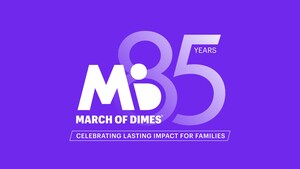Fertility Drugs Contribute Heavily to Multiple Births
March of Dimes Concerned About Drugs' Role in Growing Crisis of Prematurity
WHITE PLAINS, N.Y.,, Jan. 15 /PRNewswire-USNewswire/ -- The widespread use of so-called fertility drugs, not just high-tech laboratory procedures, likely plays a larger role than previously realized in the growing problem of premature births in the United States, because these drugs cause a high percentage of multiple births, the March of Dimes said today.
The organization's comments came in response to a study published in the American Journal of Epidemiology by authors from the Centers for Disease Control and Prevention (CDC) and the March of Dimes that found controlled ovarian hyperstimulation (COH) drugs -- used to stimulate a woman's ovaries to speed the maturity and multiply the production of eggs -- accounts for four times more live births than assisted reproductive technologies (ARTs) such as in vitro fertilization.
"Many people have focused on the role of ARTs in multiples and have not fully appreciated that fertility drugs alone are responsible for one out of every five multiple births," said Alan R. Fleischman, M.D., medical director of the March of Dimes. "COH drugs are widely prescribed, and some health care professionals -- and their patients -- are not aware of the serious risks of fertility drugs to women and their babies. There is a very high possibility of multi-fetal pregnancy resulting from use of these drugs, and that brings a high risk of prematurity and lifelong health problems for the babies as a consequence."
"The March of Dimes urges more research and leadership from professional societies to develop specific guidelines and encourage acceptance of best practices for the proper use and dosage of fertility drugs, as well as the careful counseling and monitoring of women treated with these drugs. Women who are taking fertility drugs should always ask their doctor what they can do to prevent having a multi-fetal pregnancy," Dr. Fleischman said.
Dr. Fleischman noted that approximately 88,000 babies are born preterm annually as a result of the recent increase of twins, triplets, and other multiple births. About 60 percent of twins, more than 90 percent of triplets, and virtually all quadruplets and higher-order multiples are born prematurely, he noted. In addition to the increased risks associated with multiple birth, studies have also suggested that even infants born singly, but conceived with ovulation stimulation are at increased risk for preterm delivery than naturally conceived single births, the study authors pointed out.
Dr. Fleischman said it is critical for the American Society for Reproductive Medicine, the American College of Obstetricians and Gynecologists, and other clinical societies to develop clear guidelines on the use of fertility drugs to help prevent many premature births.
The study found that 4.6 percent of live births in 2005 resulted from fertility drug use, a figure 4 times higher than the 1.2 percent of births resulting from ARTs. A total of 22.8 percent of babies born as multiples were conceived using fertility drugs alone.
The study authors conclude that more than 190,000 infants per year are conceived with fertility drug use, but also say this figure is an underestimate because there is no system for population-based surveillance of births resulting from fertility drug treatment.
"The estimates from this analysis, together with separate published estimates from the National ART surveillance system, indicate that in all, approximately 6 percent of US infants are now exposed to ovulation stimulation treatments," stated Laura Schieve, epidemiologist at the CDC's National Center on Birth Defects and Developmental Disabilities. "Thus, we must continue to study both the short- and long-term health outcomes among the many women treated and the many children annually conceived with these infertility treatments."
More than 540,000 babies are born too soon each year in the U.S. Preterm birth costs the nation more than $26 billion annually, according to the Institute of Medicine. It is the leading cause of newborn death, and babies who survive an early birth face the risk of lifelong health problems such as breathing problems, mental retardation, cerebral palsy, developmental delays, vision and hearing loss. Even babies born just a few weeks too soon (34-36 weeks gestation, also known as late preterm birth) have higher rates of death and disability than full-term babies.
The March of Dimes is the leading nonprofit organization for pregnancy and baby health. With chapters nationwide and its premier event, March for Babies(R), the March of Dimes works to improve the health of babies by preventing birth defects, premature birth and infant mortality. For the latest resources and information, visit marchofdimes.com or nacersano.org. For free access to national, state, county and city-level maternal and infant health data, visit PeriStats, at marchofdimes.com/PeriStats.
SOURCE March of Dimes
WANT YOUR COMPANY'S NEWS FEATURED ON PRNEWSWIRE.COM?
Newsrooms &
Influencers
Digital Media
Outlets
Journalists
Opted In





Share this article